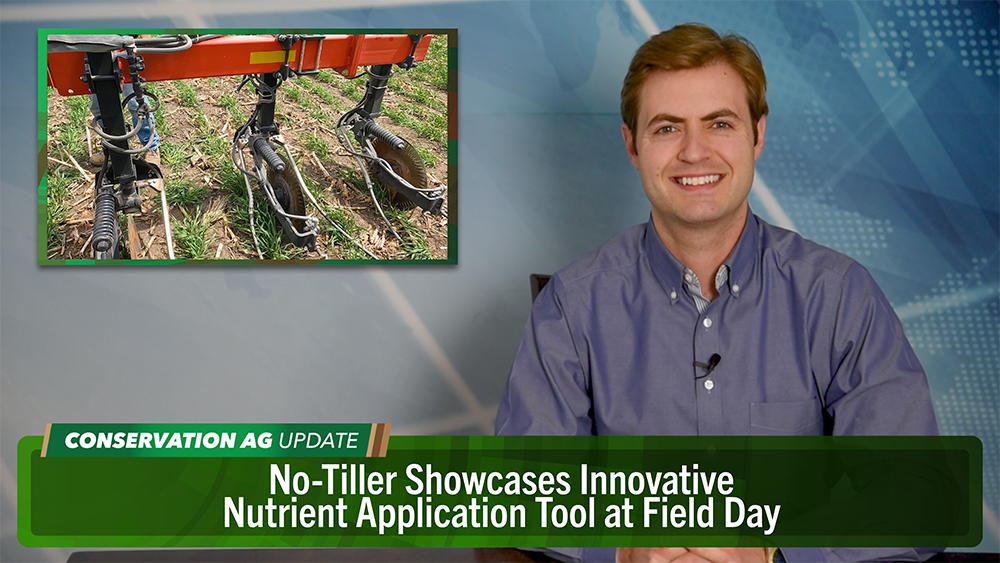In this episode of Conservation Ag Update, no-tiller Tim Recker showcases his innovative approach to nitrogen application at the “Making Big Decisions with Precision” field day event in Arlington, Iowa.
The episode also features a trip to longtime no-tiller Tom Hess’ farm in the thumb of Michigan. Hess gives us a peek at his new interseeder and shares the keys to success when it comes to interseeding cover crops into corn and soybeans.
Plus — Leaftech Ag founder John Mascoe unveils a new tool for on demand tissue analysis, a Wisconsin farmer builds his own strip-till machine and assistant editor Mackane Vogel checks in with 3 of the most unique cover crop seeders we’ve ever seen.
This episode of Conservation Ag Update is brought to you by Saddle Butte Ag Bio Till Cover Crops.
Bio Till Cover Crops, a pioneer and leader in cover crop seeds, represents a complete lineup of seeds suitable for use in diverse soil types and growing conditions. Our focus on cover crop and regenerative forage seeds sets us apart from suppliers invested in other markets. Bio Till Cover Crops is dedicated to the expansion of the cover crop market by offering a superior, proven product matched with agronomic support from our outstanding team at a fair and competitive price point.
TRANSCRIPT
Jump to a section or scroll for the full episode...
- No-Tiller Tim Recker Shows Off Nitrogen Bar at Iowa Field Day
- Cover Crop Connection
- Farmer Feature: Tom Hess, Vassar, Mich.
- Ahead of the Curve: New Handheld Tissue Analysis Tool
- Video of the Week: Old Cultivator Transforms into Strip-Till Rig
Iowa No-Tiller Shows Off Nitrogen Applicator at Field Day
“Making Big Decisions with Precision” was the theme at Tim Recker’s farm. The no-tiller showcased one of his biggest precision tools — his nitrogen bar. Recker uses it to apply nitrogen with Y drops ahead of the corn planter. Tim — show us how it works!
“I’m laying 24 gallons of liquid N, 12 on each side, and I’m putting a ribbon of 32% in this area and then I come back with the planter, and it will plant the seeds right here. My concern is, in the old days when I was doing tillage, we were blanket spreading 32% across the top, 24-30 gallons and had to work it in. Since I’m not doing any tillage, I’m not incorporating any nitrogen in but laying a ribbon of concentrate on both sides with some stabilizers and what I call car wash soap to get it into the ground quicker. And with technology you’re able to plant right between that 6-inch ribbon.”
Recker, who’s been no-tilling for about a decade, says GPS technology is key to making his nitrogen application system work.
Cover Crop Strategies Readers Submit Variety of Cover Crop Seeding Equipment
We sent out a survey to our readers about the different types of cover crop seeders they use on their farms. From standard air seeders to modified versions of classic seed drills all the way to horse and buggy, here’s a quick look at a few of the most unique and thought-provoking responses.
Jeff Samuelson from Rose Valley Farm in Tipton, Iowa says “We use a John Deere 1790, 31 by 15 inch planter with SeedRight seed discs for small grains. This gives us the chance to plant next year's corn between the cereal rye rows. We also have excellent population control, dropping around 40-45 pounds of seed per acre.”

If we head across the pond to Essex, England, Jamie Rankin of Little Hall Farms says “I use a Weaving, as this is a specialist direct drill for no-tillers. We are pleased with the drill and the switch to no cultivations, which is working well so far. An important gain is that we have more time to do the job right as we are not under pressure to get on with cultivations and thus damage our soils.”

And we promised horse and buggy solet’s head to Trout Run, Pennsylvania where Eric Nordell of Beech Grove Farm says “We use this old pull-type rotary hoe to incorporate broadcast cover crop seed. We often precede the rotary hoe with a spring tooth harrow, which was the case in this photo, planting a cover crop cocktail after no-till garlic. This combination seems to do a good job of incorporating the seed while keeping most of the residue near the soil surface and loosening the ground for good water infiltration.”
You can see more responses in the upcoming Cover Crop Strategies Special Report which will be featured in the July edition of No-Till Farmer Magazine and in an article on covercropstrategies.com
Farmer Feature: Tom Hess, Tuscola County, Mich.
Planting season is picking up steam — 65% of corn and 49% of soybeans are in the ground, according to the May 14 USDA Crop Progress Report. But wet conditions tested the patience of some farmers in states like Michigan.
That includes Tuscola County no-tiller Tom Hess, who was finally able to start planting last week. Tom’s been no-tilling for almost 40 years. No-till helps slow erosion on his hilly farm and allows him to have a life, he says — taking a lot less time and equipment to get the job done. He’s big on cover crops, planting several different species like vetch, annual ryegrass, cereal rye and radish to name a few.
He uses this Hiniker 12-row cover crop interseeder while side dressing corn around V3-V5.
“Our goal is to keep it green, keep something pulling sunlight and converting that into feed for the biology down under our feet. Our goal is to keep the ground covered, with as little soil disturbance as possible and keep a living root year-round. With the mild winters we’re keeping something relatively green all winter.”
“What’s one of the keys to success when it comes to interseeding?”
“It’s timing. It’s a busy time of the year so it takes some management to have everything ready to go. We all know corn goes from 6 inches to 6 feet in about 3 weeks it seems like. You have to be ready to go and cover the ground. It’s going to be one of the big challenges, the equipment availability and the manpower to run it.”
Ahead of the Curve: New Handheld Tissue Analysis Tool
At the National No-Tillage Conference in January I talked with a farmer who uses a lot of precision technology. I asked him what new technology or product would really take his operation to the next level? He said, something that could make tissue sampling easier and quicker.
This could be what he’s looking for. Leaftech Ag recently debuted this handheld tissue analysis tool at Linco-Precision’s new technology meeting in Nokomis, Ill. The digital lab delivers nutrient content readings in less than 3 minutes. Leaftech founder John Mascoe says all you do is stick a leaf in the scanner bed and wait for the magic to happen.
“It allows you to identify your farm field crop, and then allows you to calibrate the scanner with that information. From there you’re able to capture the leaf nondestructively to look at the nutrients and we collect about a 3-5 inch area. Then you go to your scan results where it pushes the data up to the cloud. It allows you to see the data for all the crop nutrients plus the leaf water content. Leaf water content is important because it allows us to determine water stress on the plant and also gives us all the meta data on where it was and how it was used.”
Video of the Week: Old Cultivator Transforms into Strip-Till Rig
More ingenuity on display in our video of the week, coming to us from Columbus, Wisconsin, where Jeff Gaska built his own strip-till rig.
Check it out — he used an old 12-row cultivator as the main frame and transformed it into a strip-till machine. Some of the features include row cleaners, a single coulter for depth gauge and to cut through trash, a mole knife running about 6 inches deep to break up the soil and 2 coulters in the back to build the mound for the strips.
Have an interesting photo or video from your farm? Or a story you’d like us to feature on the broadcast? Send me an email at Nnewman@lesspub.com.
And that will wrap things up on the first edition of Conservation Ag Update. Until next time, for more stories visit no-tillfarmer.com, striptillfarmer.com and covercropstrategies.com. Thanks for stopping by. Have a great day!








